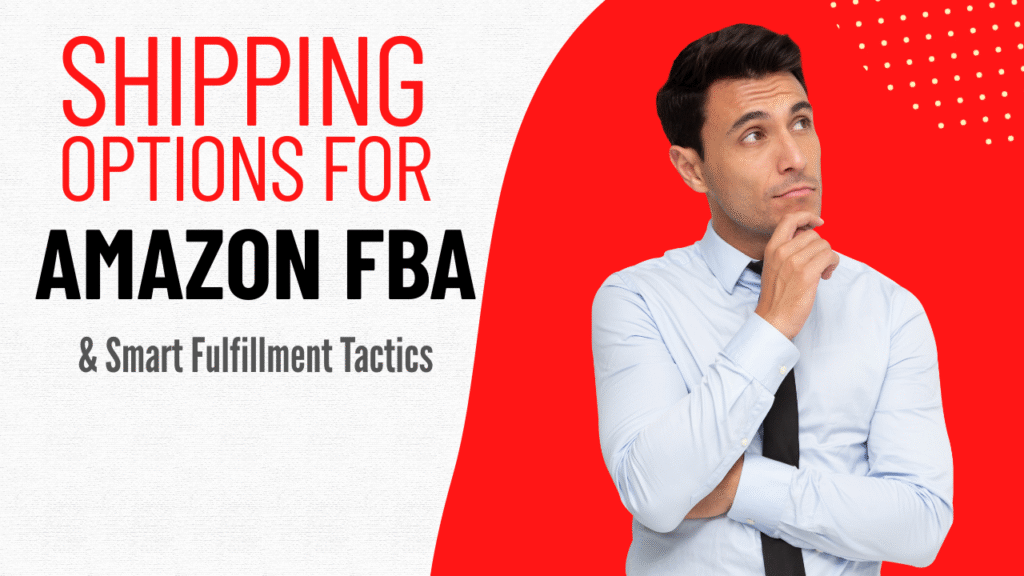
Introduction
Entrepreneurs now sell online through Amazon FBA, which has revolutionized their sales approach. Sellers utilize Amazon’s vast logistics network to outsource their storage requirements and shipping tasks and can even delegate customer service duties. Thousands of businesses, including solo side hustlers and large-scale private label brands, can now reach their customers with Prime speed and professional fulfillment through this model.
Amazon FBA offers convenience but presents multiple challenges. In today’s market conditions, sellers face rising fees while competing fiercely and experiencing shrinking profits, which makes cost efficiency mastery an essential survival skill. Shipping stands out as the biggest expense throughout the FBA experience. Errors in carrier selection and fulfillment strategies will eat away at profits before any sales occur.
This detailed guide explains the least expensive shipping method for Amazon FBA while also reviewing effective fulfillment strategies and assessing reliable “done-for-you” Amazon solutions and dependable FBA packaging options. This article provides valuable insights for both new sellers launching their first product and seasoned sellers who want to optimize their logistics to strengthen their business foundation and improve profitability.
How to Ship to Amazon FBA at Minimum Costs Without Sacrificing Quality
Without proper management, shipping costs can silently drain your Amazon FBA profit margins. New sellers tend to overlook the speed at which their costs increase because of regular or inefficient shipping practices. Running a lean and scalable FBA business requires immediate implementation of the least expensive yet most efficient shipping methods.
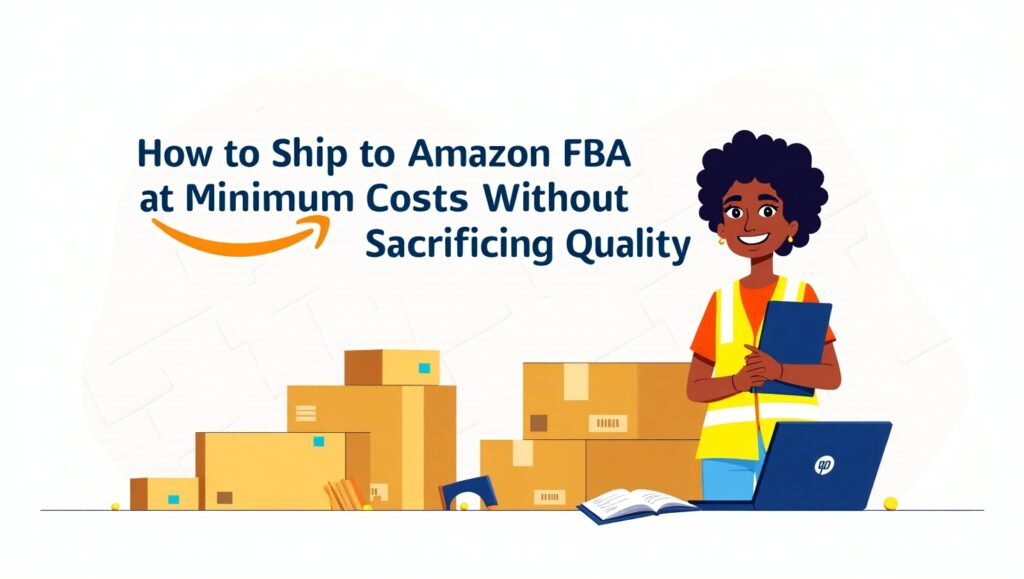
Understanding Amazon’s Strict Requirements
Before sending out any items, you need to understand and follow Amazon’s strict guidelines for inbound shipping and packaging. Amazon dictates specific rules that cover the entire process of packaging boxes and attaching labels. All products shipped to Amazon require proper FNSKU barcoding and must be delivered in boxes that meet dimensional standards and packaging requirements for safe transit.
Non-compliance with the rules will result in shipment delays or rejections, and you will incur extra costs for repackaging or relabeling. Non-compliance with shipping and packaging rules will damage your seller performance metrics and restrict your selling privileges. The allocation of your inventory across multiple fulfillment centers by Amazon leads to separate shipments, which increase your shipping costs and complicate logistical arrangements.
Amazon Partnered Carrier Program: The Go-To for Cost Efficiency
The Partnered Carrier Program from Amazon provides domestic U.S. sellers with the most economical shipping solution to FBA warehouses. The Partnered Carrier Program focuses on UPS services while providing substantial discounts that reduce shipping costs by 50–70% below regular retail prices. The shipping workflow within Seller Central enables sellers to utilize this option.
To illustrate:
Sellers using Amazon’s Partnered Carrier Program pay around $30 for shipping four 50-lb boxes, while third-party carriers like FedEx or USPS charge $70 to $100 based on distance and volume. Organizations shipping products weekly or monthly achieve savings that compound as time passes.
Real-World Example:
A U.S.-based beauty product seller cut their monthly shipping bill by $520 by moving from USPS to Amazon’s Partnered Carrier Program for biweekly shipments.
Shipping Large Volumes? Consider Freight and LTL
When shipping palletized goods or larger inventory quantities, Less Than Truckload (LTL) shipping through freight brokers presents a better solution. Amazon permits LTL shipments to arrive at its fulfillment centers only when specific scheduling requirements are met. Pallet shipping for 500 units offers a lower cost per unit when compared to the parcel delivery of 100 units.
Establish a partnership with a seasoned Amazon freight forwarder or 3PL provider to maintain effective supply chain coordination. Consolidating multiple supplier shipments into a single large shipment results in significant shipping cost reductions per unit.
International Sellers: Freight Forwarding is Your Ally
Shipping directly to FBA centers from outside the United States involves both high expenses and complicated processes because of customs clearance requirements and import duties. This is where freight forwarders shine. Freight forwarders combine your shipments with those of other sellers, handle customs clearance, and usually provide preparation services before sending goods to Amazon FBA.
Flexport, Shipito, and Freightos deliver global shipping solutions designed for Amazon sellers that help manage costs effectively. Their services help minimize problems with customs hold-ups and Amazon delivery scheduling demands.
Use Shipping Calculators to Compare Costs
Platforms such as ShipStation and Pirate Ship, and Easyship offer shipping calculators that enable users to compare live rates across different carriers. Amazon sellers who use the Partnered Carrier Program should regularly evaluate their shipping rates against competitors to ensure they remain competitive during peak seasons when rates change frequently.
Statistical Insight:
JungleScout surveyed in 2024, which included 2,000 Amazon sellers.
- According to a 2024 JungleScout survey of 2,000 Amazon sellers, 68% experienced more than a 40% reduction in shipping costs after adopting Amazon’s Partnered Carrier Program.
- Through consolidation strategies, 32% of sellers using freight forwarding from China to the U.S. managed to cut shipping costs per unit from $1.70 down to $0.80.
Insider Tip:
Beginners should steer clear of sending multiple small shipments. You should combine your inventory into bigger shipments, which are dispatched less frequently. You can use Amazon’s Multi-Channel Fulfilment (MCF) to process orders beyond Amazon platforms, which helps you get the most out of every shipment.
What methods exist to reduce Amazon FBA shipping costs for small sellers?
Small sellers should optimize their shipping approach by combining fewer shipments with larger shipment box quantities. Customers who use recycled packaging materials can decrease shipping costs if they follow Amazon’s packaging guidelines. Regional shipping companies, OnTrac and Spee-Dee, have the potential to lower shipping costs in particular regions. Online shipping rate comparison requires sellers to regularly use platforms like Pirate Ship along with Easyship and ShipStation.
Mastering FBA Fulfilment: Unlock Seamless, Profitable Logistics
Amazon offers FBA fulfilment, which manages your product storage and handles all aspects of delivery to your customers. The service appears straightforward, yet improper usage results in excessive fees and poor inventory management.

The primary advantage of using FBA is the ability to obtain the Prime badge for fulfilled products. The Prime shipping qualification for Amazon-fulfilled products results in improved product visibility and higher conversion rates. However, this comes at a cost. Amazon charges fees for monthly and long-term storage services while also applying fulfillment charges per unit and return processing fees and other additional expenses. To maintain profitability,y sellers must thoroughly understand all relevant fees.
According to a Marketplace Pulse 2023 report, the average fulfilment cost per unit rose by 12% compared to last year, which highlights that sellers must become more cost-conscious.
The early distribution of excessive inventory remains a frequent error among new sellers. Long-term storage fees can significantly reduce your profits. Amazon’s Inventory Performance Index (IPI) serves as a tool to enable sellers to monitor their inventory management efficiency. Your storage fees decrease when your IPI score reaches higher levels.
There are two fulfilment methods: FBA and FBM (Fulfilment by Merchant). FBM provides greater control and potential cost savings for slow-moving or oversized products compared to FBA’s convenience. Successful sellers who combine fulfillment methods use FBA to ship fast-moving products while processing niche products through FBM.
Amazon FBA Done for You: The Ultimate Hassle-Free Selling Solution
“Done for You” (DFY) Amazon FBA services provide complete solutions as agencies or experts manage all business operations from product research to shipping and listing optimization. Busy professionals, along with first-time sellers and international entrepreneurs, demonstrate growing interest in these services.
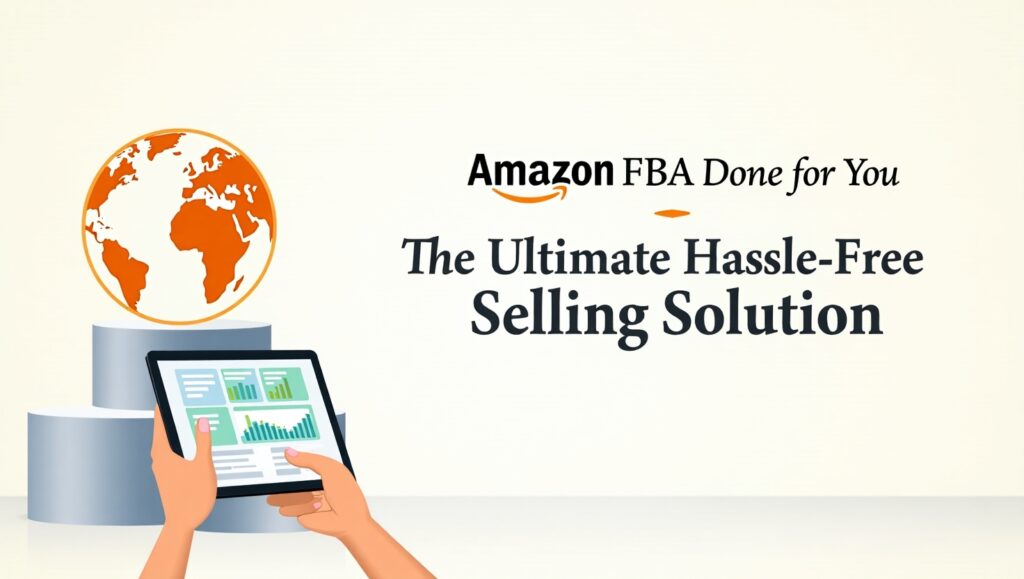
A DFY service transforms market entry for aspiring Amazon sellers who don’t have enough time or specialized knowledge. DFY services combine fundamental business functions into one package.
- Product selection and market analysis
- Supplier sourcing and negotiations
- Brand building and listing creation
- Shipping and customs handling
- FBA preparation and launch strategy
However, these conveniences come at a cost. DFY service packages start at $5,000 for entry-level options but may exceed $30,000 based on project requirements. Successful DFY projects demonstrate that despite their substantial initial costs, case studies report monthly revenue generation between $10,000 to $50,000 during the first year.
Case Study:
A successful businessperson from the U.K. invested $12,000 into a DFY agency. The business achieved gross sales exceeding $80,000 during the first eight months. The seller achieved financial balance by the end of month six before quickly expanding to launch a second product line. The agency’s continuous account monitoring alongside their optimized launch strategy and thorough market research led to their success.
Thorough vetting of these providers remains a fundamental requirement. Choose agencies that provide pricing transparency along with verified client reviews and clear engagement terms. Don’t choose agencies that guarantee quick success without offering client testimonials.
Discover the best Amazon FBA Packaging Services that optimize both your time and money.
The choice of packaging materials goes further than just boxes and bubble wrap because it affects both your FBA costs and customer service perception. If you fail to meet the strict packaging and preparation standards set by Amazon you could face shipment hold-ups or financial penalties.
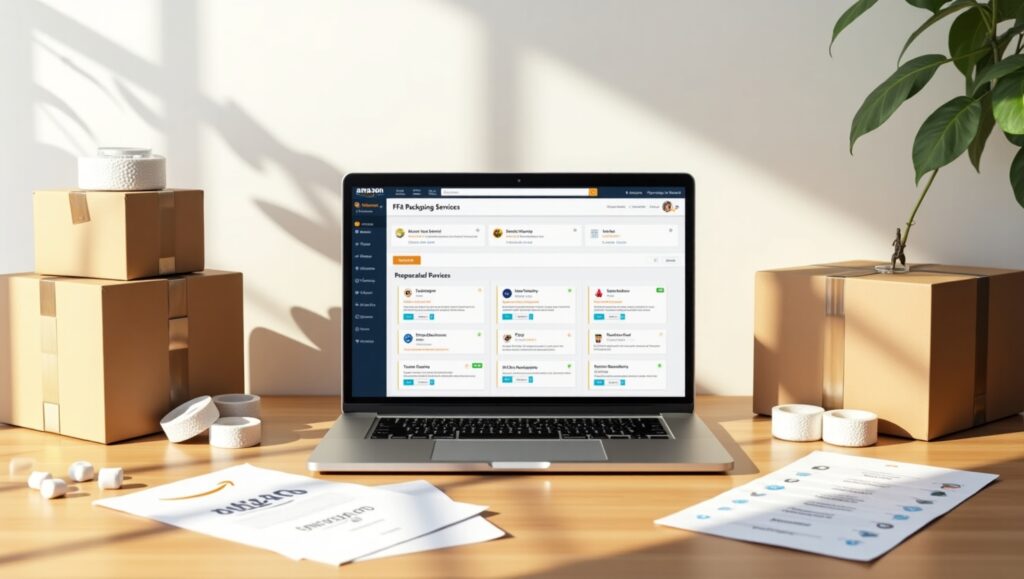
By using professional packaging services, you can ensure regulatory compliance while dedicating your time to other aspects of your business. These companies typically offer:
- FNSKU labeling
- Poly bagging and bubble wrapping
- Custom packaging and inserts
- Kitting and bundling services
Your choice of packaging service should match your business size and product specifications, along with your financial resources. My FBA Prep alongside ShipBob and PrepFBA stand out as dependable solutions that scale effectively.
Let’s compare the cost:
| Packaging Task | DIY Cost (Per Unit) | Professional Service Cost (Per Unit) |
| Labeling | $0.10 | $0.15 |
| Bubble Wrapping | $0.20 | $0.25 |
| Kitting | $0.50 | $0.60 |
While professional packaging solutions may initially cost more, they minimize mistakes and boost customer satisfaction, leading to better reviews and enhanced long-term profits.
Successful FBA operations begin with efficient shipping and fulfillment processes.
To succeed in the Amazon FBA ecosystem, businesses must achieve cost reductions while maintaining high-quality standards. Through effective use of Amazon’s partnered shipping programs, careful selection of fulfillment methods, strategic exploration of DFY services, and intelligent outsourcing of packaging businesses can maintain their profit margins while expanding their operations.
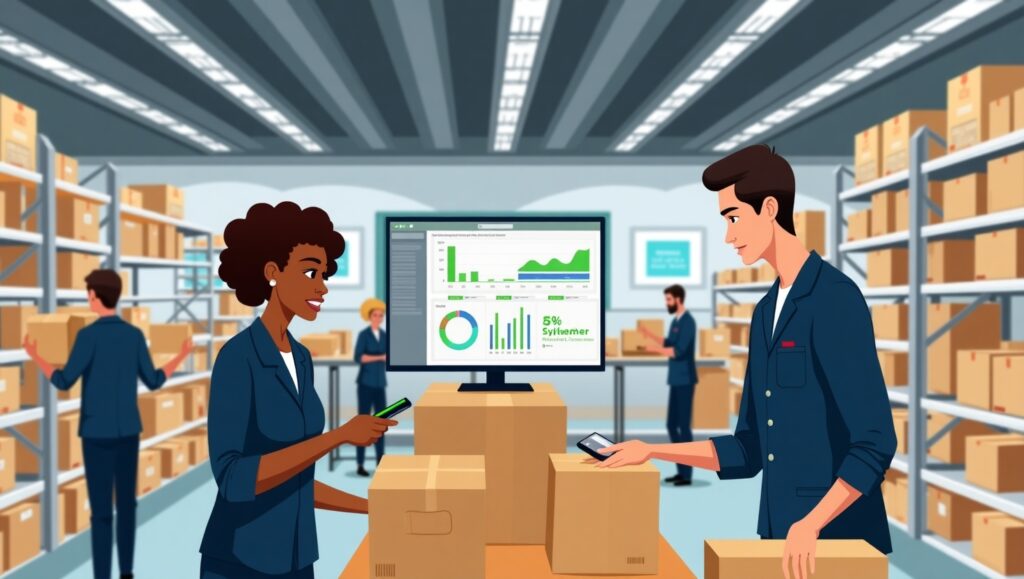
Reducing shipping and fulfilment expenses leads to an equivalent increase in profit margins. Amid growing competition on Amazon’s operational efficiency has become essential. By staying updated with Amazon’s changing requirements and regularly tracking expenses, sellers can develop more robust businesses that scale effectively.
FAQs
Q1. Can my supplier ship my products directly to Amazon FBA?
A common practice among sellers includes shipping products directly to Amazon FBA warehouses from their Chinese suppliers. Your supplier needs to comply with Amazon’s requirements or use a preparation center service.
Q2. Amazon’s shipping costs through its partnered carriers vary according to the shipment’s weight and destination.
Shipping rates vary according to package weight and delivery location, while discounts for customers lower shipping costs by 70% of typical retail shipping fees.
Q3. How can sellers optimize their inventory management when using FBA?
Minimize long-term fees by using Amazon’s inventory tools to maintain restock balance and prevent overstocking.
Q4. Are DFY Amazon FBA services legit?
Several DFY Amazon FBA services are trustworthy, yet some operate as scams. Research providers thoroughly and verify client results.
Q5. Can I switch between FBA and FBM?
Yes, you can change fulfillment methods anytime. Sellers often use a hybrid approach depending on the performance and size of their products.
Q6. Do packaging services offer international support?
Numerous premier prep and packaging services assist international sellers who want to transact in the U.S. market.

